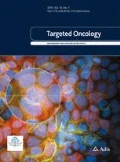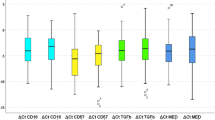Abstract
The aim of this study was to analyse the expression of 1,25-dihydroxyvitamin D3 receptor (VDR) in oral cancers are squamous cell carcinomas (OSCC) to evaluate whether oral tissue may be a new potential target for biologically active 1,25-(OH)2D3 or its analogues. Expression of VDR was analysed in OSCC specimen (n = 191) and cancer cell lines (BICR3, BICR56) by immunohistochemistry, real-time polymerase chain reaction (RT-PCR) analysis, and Western blotting. Scanned images were digitally analysed using ImageJ and the immunomembrane plug-in. VDR expression on protein level was correlated with proliferation marker Ki-67, clinical characteristics and impact on survival. VDR was co-labelled with CD44 and Ki-67 in double labeling experiments. Expression subgroups were identified by receiver operating characteristics (ROC) analysis. Low VDR expression was significantly associated with recurrence of the tumour. Multivariate analysis demonstrated low VDR expression as an independent prognostic factor (p = 0.0005). Immunohistochemical double staining revealed VDR expression by CD44+ cancer cells. An inverse correlation of VDR+ expressing cancer cells with Ki-67 has been found, which was indicated by immunofluorescence double labeling. VDR specificity was confirmed by Western blot and RT-PCR analysis. For the first time, our study provides evidence that decreased VDR expression in OSCC might be associated with tumour relapse. Tumour cells of a putative CD44+ cancer stem cell compartment express VDR indicating a potential Achilles’ heel for the treatment of OSCC although, our results do not allow any conclusion on the function of VDR. Adjuvant chemoprevention by using 1,25-(OH)2D3 or its analogues can be a successful tool targeting adjuvant residual tumour cells and will likely help therapeutic optimization for cancer patients in the clinic. However, this hypothesis requires further in vitro and in vivo studies.






Similar content being viewed by others
Abbreviations
- OSCC:
-
Oral squamous cell carcinoma
- HNSCC:
-
Head and neck squamous cell carcinoma
- HE:
-
Hematoxylin and eosin
- ROC:
-
Receiver operating characteristics analysis
- AUC:
-
Area under the curve analysis
References
Parkin DM, Laara E, Muir CS (1988) Estimates of the worldwide frequency of sixteen major cancers in 1980. Int J Cancer 41(2):184–197
da Silva SD, Ferlito A, Takes RP, Brakenhoff RH, Valentin MD, Woolgar JA, Bradford CR, Rodrigo JP, Rinaldo A, Hier MP, Kowalski LP (2011) Advances and applications of oral cancer basic research. Oral Oncol 47(9):783–791. doi:10.1016/j.oraloncology.2011.07.004
Yu Y, Ramena G, Elble RC (2012) The role of cancer stem cells in relapse of solid tumours. Front Biosci (Elite Ed) 4:1528–1541
Dean M (2009) ABC transporters, drug resistance, and cancer stem cells. J Mammary Gland Biol Neoplasia 14(1):3–9. doi:10.1007/s10911-009-9109-9
Prince ME, Sivanandan R, Kaczorowski A, Wolf GT, Kaplan MJ, Dalerba P, Weissman IL, Clarke MF, Ailles LE (2007) Identification of a subpopulation of cells with cancer stem cell properties in head and neck squamous cell carcinoma. Proc Natl Acad Sci U S A 104(3):973–978. doi:10.1073/pnas.0610117104
Zhang Z, Filho MS, Nor JE (2012) The biology of head and neck cancer stem cells. Oral Oncol 48(1):1–9. doi:10.1016/j.oraloncology.2011.10.004
Tobias JS (1990) Has chemotherapy proved itself in head and neck cancer? Br J Cancer 61(5):649–651
Bernier J, Domenge C, Ozsahin M, Matuszewska K, Lefebvre JL, Greiner RH, Giralt J, Maingon P, Rolland F, Bolla M, Cognetti F, Bourhis J, Kirkpatrick A, van Glabbeke M (2004) Postoperative irradiation with or without concomitant chemotherapy for locally advanced head and neck cancer. N Engl J Med 350(19):1945–1952. doi:10.1056/NEJMoa032641350/19/1945
Cooper JS, Pajak TF, Forastiere AA, Jacobs J, Campbell BH, Saxman SB, Kish JA, Kim HE, Cmelak AJ, Rotman M, Machtay M, Ensley JF, Chao KS, Schultz CJ, Lee N, Fu KK (2004) Postoperative concurrent radiotherapy and chemotherapy for high-risk squamous-cell carcinoma of the head and neck. N Engl J Med 350(19):1937–1944. doi:10.1056/NEJMoa032646350/19/1937
Visvader JE, Lindeman GJ (2008) Cancer stem cells in solid tumours: accumulating evidence and unresolved questions. Nat Rev Cancer 8(10):755–768. doi:10.1038/nrc2499
Garland C, Shekelle RB, Barrett-Connor E, Criqui MH, Rossof AH, Paul O (1985) Dietary vitamin D and calcium and risk of colorectal cancer: a 19-year prospective study in men. Lancet 1(8424):307–309
Colston K, Colston MJ, Feldman D (1981) 1,25-Dihydroxyvitamin D3 and malignant melanoma: the presence of receptors and inhibition of cell growth in culture. Endocrinology 108(3):1083–1086
Abe E, Miyaura C, Sakagami H, Takeda M, Konno K, Yamazaki T, Yoshiki S, Suda T (1981) Differentiation of mouse myeloid leukemia cells induced by 1 alpha,25-dihydroxyvitamin D3. Proc Natl Acad Sci U S A 78(8):4990–4994
Palmer HG, Gonzalez-Sancho JM, Espada J, Berciano MT, Puig I, Baulida J, Quintanilla M, Cano A, de Herreros AG, Lafarga M, Munoz A (2001) Vitamin D(3) promotes the differentiation of colon carcinoma cells by the induction of E-cadherin and the inhibition of beta-catenin signaling. J Cell Biol 154(2):369–387
Vink-van Wijngaarden T, Pols HA, Buurman CJ, Birkenhager JC, van Leeuwen JP (1996) Inhibition of insulin- and insulin-like growth factor-I-stimulated growth of human breast cancer cells by 1,25-dihydroxyvitamin D3 and the vitamin D3 analogue EB1089. Eur J Cancer 32A(5):842–848
Park WH, Seol JG, Kim ES, Jung CW, Lee CC, Binderup L, Koeffler HP, Kim BK, Lee YY (2000) Cell cycle arrest induced by the vitamin D(3) analog EB1089 in NCI-H929 myeloma cells is associated with induction of the cyclin-dependent kinase inhibitor p27. Exp Cell Res 254(2):279–286. doi:10.1006/excr.1999.4735
Skowronski RJ, Peehl DM, Feldman D (1993) Vitamin D and prostate cancer: 1,25 dihydroxyvitamin D3 receptors and actions in human prostate cancer cell lines. Endocrinology 132(5):1952–1960
Kornfehl J, Formanek M, Temmel A, Knerer B, Willheim M (1996) Antiproliferative effects of the biologically active metabolite of vitamin D3 (1,25 [OH]2D3) on head and neck squamous cell carcinoma cell lines. Eur Arch Otorhinolaryngol: Off J Eur Fed Otorhinolaryngol Soc 253(6):341–344
Meier JD, Enepekides DJ, Poirier B, Bradley CA, Albala JS, Farwell DG (2007) Treatment with 1-alpha,25-dihydroxyvitamin D3 (vitamin D3) to inhibit carcinogenesis in the hamster buccal pouch model. Arch Otolaryngol Head Neck Surg 133(11):1149–1152. doi:10.1001/archotol.133.11.1149
Kulbersh JS, Day TA, Gillespie MB, Young MR (2009) 1alpha,25-Dihydroxyvitamin D(3) to skew intratumoural levels of immune inhibitory CD34(+) progenitor cells into dendritic cells. Otolaryngol Head Neck Surg: Off J Am Acad Otolaryngol Head Neck Surg 140(2):235–240. doi:10.1016/j.otohns.2008.11.011
Young MR, Wright MA, Lozano Y, Prechel MM, Benefield J, Leonetti JP, Collins SL, Petruzzelli GJ (1997) Increased recurrence and metastasis in patients whose primary head and neck squamous cell carcinomas secreted granulocyte-macrophage colony-stimulating factor and contained CD34+ natural suppressor cells. Int J Cancer J Inter du Cancer 74(1):69–74
Lu L, Qiu J, Liu S, Luo W (2008) Vitamin D3 analogue EB1089 inhibits the proliferation of human laryngeal squamous carcinoma cells via p57. Mol Cancer Ther 7(5):1268–1274. doi:10.1158/1535-7163.MCT-07-2222
Hager G, Kornfehl J, Knerer B, Weigel G, Formanek M (2004) Molecular analysis of p21 promoter activity isolated from squamous carcinoma cell lines of the head and neck under the influence of 1,25(OH)2 vitamin D3 and its analogs. Acta Otolaryngol 124(1):90–96
Satake K, Takagi E, Ishii A, Kato Y, Imagawa Y, Kimura Y, Tsukuda M (2003) Anti-tumour effect of vitamin A and D on head and neck squamous cell carcinoma. Auris, nasus, larynx 30(4):403–412
Prudencio J, Akutsu N, Benlimame N, Wang T, Bastien Y, Lin R, Black MJ, Alaoui-Jamali MA, White JH (2001) Action of low calcemic 1alpha,25-dihydroxyvitamin D3 analogue EB1089 in head and neck squamous cell carcinoma. Journal of the National Cancer Institute 93(10):745–753
So JY, Lee HJ, Smolarek AK, Paul S, Wang CX, Maehr H, Uskokovic M, Zheng X, Conney AH, Cai L, Liu F, Suh N A novel Gemini vitamin D analog represses the expression of a stem cell marker CD44 in breast cancer. Mol Pharmacol. doi:10.1124/mol.110.068403
Kumagai T, O'Kelly J, Said JW, Koeffler HP (2003) Vitamin D2 analog 19-nor-1,25-dihydroxyvitamin D2: antitumour activity against leukemia, myeloma, and colon cancer cells. J Natl Cancer Inst 95(12):896–905
Sobin LH, Wittekind CH (2010) UICC. TNM classification of malignant tumours, 7th edn. Springer Verlag, Berlin
Hamilton SR, Aaltonen LA (2000) Pathology and Ggenetics. Tumours of the digestive system, 3rd edn. IARC Press, Lyon
von Rahden BH, Kircher S, Kafka M, Stuermer L, Reiber C, Gattenlohner S, Germer CT, Grimm M (2010) Glucocorticoid-induced TNFR family-related receptor (GITR)-expression in tumour infiltrating leucocytes (TILs) is associated with the pathogenesis of esophageal adenocarcinomas with and without Barrett’s mucosa. Canc Biomarkers: Sec A Dis Markers 7(6):285–294. doi:10.3233/CBM-2010-0192
Grimm M, Lazariotou M, Kircher S, Stuermer L, Reiber C, Hofelmayr A, Gattenlohner S, Otto C, Germer CT, von Rahden BH (2010) MMP-1 is a (pre-)invasive factor in Barrett-associated esophageal adenocarcinomas and is associated with positive lymph node status. J Transl Med 8:99. doi:10.1186/1479-5876-8-99
Alexander D, Hoffmann J, Munz A, Friedrich B, Geis-Gerstorfer J, Reinert S (2008) Analysis of OPLA scaffolds for bone engineering constructs using human jaw periosteal cells. J Mater Sci Mater Med 19(3):965–974. doi:10.1007/s10856-007-3351-8
Alexander D, Schafer F, Olbrich M, Friedrich B, Buhring HJ, Hoffmann J, Reinert S (2010) MSCA-1/TNAP selection of human jaw periosteal cells improves their mineralization capacity. Cell Physiol Biochem 26(6):1073–1080. doi:10.1159/000323985
Zweig MH, Campbell G (1993) Receiver-operating characteristic (ROC) plots: a fundamental evaluation tool in clinical medicine. Clin Chem 39(4):561–577
Kaplan EL, Meier P (1958) Nonparametric estimation from incomplete observations. J Am Stat Assoc 75:457–487
Mantel N (1966) Evaluation of survival data and two new rank order statistics arising in its consideration. Cancer Chemother Rep 50(3):163–170
Cox DR (1972) Regression models and life tables. J R Stat Soc 34:1987–2001
Reichrath J, Rafi L, Muller SM, Mink D, Reitnauer K, Tilgen W, Schmidt W, Friedrich M (1998) Immunohistochemical analysis of 1,25-dihydroxyvitamin D3 receptor in cervical carcinoma. Histochem J 30(8):561–567
Mack B, Gires O (2008) CD44s and CD44v6 expression in head and neck epithelia. PLoS One 3(10):e3360. doi:10.1371/journal.pone.0003360
Harper LJ, Costea DE, Gammon L, Fazil B, Biddle A, Mackenzie IC (2010) Normal and malignant epithelial cells with stem-like properties have an extended G2 cell cycle phase that is associated with apoptotic resistance. BMC Cancer 10:166. doi:10.1186/1471-2407-10-166
Mackenzie IC (2004) Growth of malignant oral epithelial stem cells after seeding into organotypical cultures of normal mucosa. J Oral Pathol Med: Official Publ Int Assoc J Oral Pathol Am Acad Oral Pathol 33(2):71–78
Richard V, Pillai MR (2010) The stem cell code in oral epithelial tumourigenesis: ‘the cancer stem cell shift hypothesis’. Biochim Biophys Acta 1806(2):146–162. doi:10.1016/j.bbcan.2010.06.004
Zeljic K, Supic G, Stamenkovic Radak M, Jovic N, Kozomara R, Magic Z (2012) Vitamin D receptor, CYP27B1 and CYP24A1 genes polymorphisms association with oral cancer risk and survival. J Oral Pathol Med Off Pub Int Assoc Oral Pathol Am Acad Oral Pathol. doi:10.1111/j.1600-0714.2012.01164.x
Costa EM, Feldman D (1987) Measurement of 1,25-dihydroxyvitamin D3 receptor turnover by dense amino acid labeling: changes during receptor up-regulation by vitamin D metabolites. Endocrinology 120(3):1173–1178
Wiese RJ, Uhland-Smith A, Ross TK, Prahl JM, DeLuca HF (1992) Up-regulation of the vitamin D receptor in response to 1,25-dihydroxyvitamin D3 results from ligand-induced stabilization. J Biol Chem 267(28):20082–20086
Mangelsdorf DJ, Pike JW, Haussler MR (1987) Avian and mammalian receptors for 1,25-dihydroxyvitamin D3: in vitro translation to characterize size and hormone-dependent regulation. Proc Natl Acad Sci U S A 84(2):354–358
Lehmann B (1997) HaCaT cell line as a model system for vitamin D3 metabolism in human skin. J Investig Dermatol 108(1):78–82
Bouillon R, Carmeliet G, Verlinden L, van Etten E, Verstuyf A, Luderer HF, Lieben L, Mathieu C, Demay M (2008) Vitamin D and human health: lessons from vitamin D receptor null mice. Endocr Rev 29(6):726–776. doi:10.1210/er.2008-0004
Pillai S, Bikle DD, Elias PM (1988) 1,25-Dihydroxyvitamin D production and receptor binding in human keratinocytes varies with differentiation. J Biol Chem 263(11):5390–5395
Acknowledgments
We thank Julia Fertinger, Mohammed Saleh, and Besher Shokri for their technical assistance.
Conflict of interests
The authors declare that they have no competing interests.
Author information
Authors and Affiliations
Corresponding author
Additional information
An erratum to this article is available at http://dx.doi.org/10.1007/s11523-017-0523-4.
Rights and permissions
About this article
Cite this article
Grimm, M., Alexander, D., Munz, A. et al. Is 1,25-dihydroxyvitamin D3 receptor expression a potential Achilles’ heel of CD44+ oral squamous cell carcinoma cells?. Targ Oncol 8, 189–201 (2013). https://doi.org/10.1007/s11523-013-0255-z
Received:
Accepted:
Published:
Issue Date:
DOI: https://doi.org/10.1007/s11523-013-0255-z




